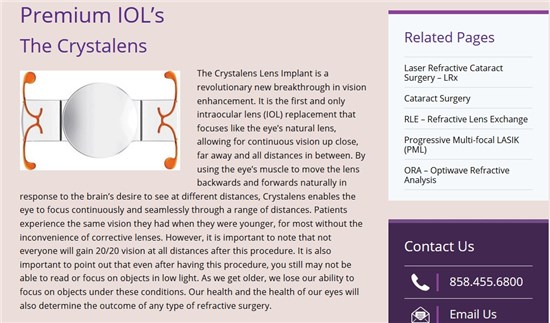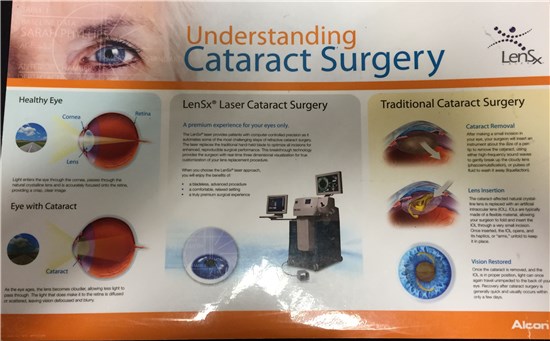By David I. Geffen, OD, FAAO

August 19, 2015
Premium IOLs, any lens beyond the standard Medicare-covered IOL, such as multifocals, accommodative and topics, often provide patients with better vision than they would otherwise experience after cataract surgery. Educating patients about the benefits of these lenses also is a practice-builder, as they enhance cataract co-management profitability.
In my shared OD-MD practice, 73 percent of the IOLs our patients are provided with are premium. For conventional cataract surgery, the co-managing doctor can expect to receive about $90 per eye. For premium IOLs, torics and multifocals, the doctor may receive between $400-$600 per eye. Most co-managing surgeons will pay the OD a fee based on the level of difficulty in the follow-up care demanded by premium IOLs.
ODs are often the first to diagnose the cataracts, and increasingly handle the pre- and post-operative visits necessary for the procedure, and set the tone for the conversation the patient will have with the surgeon. If the surgeon and the OD work well together, then the OD can help the patient by explaining options and setting them up for the consultation with the surgeon. Some people need time before making decisions. The OD presenting the options gives patients the time, so that when they are in the MD’s office, the decision can be made more quickly and with better education.
The page on Dr. Geffen’s practice web site devoted to educating patients on premium IOLs. Dr. Geffen says ODs have a responsibility to educate patients about the best option for their eyes, even if those options are more expensive.
Right for Many Patients
There is no particular demographic for acceptance of premium IOLs. Many patients, who you think can’t afford these lenses, find a way to pay for them because they see the great advantages. Optometrists are notorious for prejudging patients. We do it with progressives, as well as frames. Recommend what is best, and many people will find a way to get them. Obviously, there are some people who just can’t afford them, but many more patients than you may realize can afford these lenses–especially when they learn all the benefits.
Rather than acting as banker, and prejudging which patients can and cannot afford premium IOLs, it’s best to focus on the benefits. Once patients know how much they will be getting for the money they spend, many will end up finding a way to make it happen.
Educate Patients About Benefits, Not Fees
Just like we would never fit a 2 diopter astigmat with spherical soft lenses, doctors need to educate their patients about IOL lens options. They need to explain that just as the patient wears glasses or contact lenses to accommodate their astigmatism and other needs, the ideal IOL for them will do the same.
The optometrist should not go over the fees in detail because that is the job of the surgery center. I will typically say to the patient: “There are exciting new lens options for you. I recommend a toric IOL for you to correct your astigmatism, and these lenses will cost more than what Medicare covers, but there are many benefits to this lens. You can still get the standard type of lenses, but these are much better. These lenses will correct your astigmatism for both near and far vision.” An OD should be able to give at least a general idea of how much extra the IOLs will be, since that is going to be the first question out of the patient’s mouth. It’s important to have a great working relationship with the surgeon’s office, so you know the answer.
Premium IOLs have a significant out-of-pocket portion the patient must pay, in addition to what the insurance will cover.
A poster in Dr. Geffen’s office, educating patients about the process of cataract surgery. Dr. Geffen says it is important to educate patients about what to expect, including the premium IOL options available to them.
Use IOL Company Reps to Educate Staff
Your staff needs to understand the differences between the lenses. We utilize the company sales representatives to come and educate the staff. You don’t necessarily need to carve out extra time for this education to occur. One way to easily work IOL education into your regular routine is to invite IOL company reps to your regular weekly or monthly staff meetings.
These reps can teach the staff about the technical details about the IOLs they sell, but more importantly, they can talk to staff about key benefits to explain to patients. For example, if it’s a standard multifocal IOL, they might explain how to work with the patient to show them how these lenses will enable them to read most materials without the aid of reading glasses, while at the same time, allowing them to have the distance vision they need to drive and enjoy leisure activities like going to the movies.
If the patient is astigmatic, the rep might give the staff pointers on explaining how these IOLs are able to achieve the same vision, or nearly the same vision, that their custom progressive eyeglasses or toric multifocal contact lenses are achieving.
They can also point out to staff when you need to manage expectations with patients–that there may be certain patients who will still need glasses for some activities.
The surgeon can assist in helping the IOL reps get to the OD’s office, but the Alcon, AMO and Bausch + Lomb contact lens and solution reps have access to educational materials, and can assist in getting the IOL reps to call on the OD’s office, too.
Use Point-of-Sale Materials from Vendors
Vendors are happy to supply educational aids for your office. We use many of these in both the reception area and chair-side. Point-of-sale posters, counter cards and brochures are important to keep in your reception area because these materials serve as conversation-starters with patients. Even before you or your staff has a chance to talk with patients about their premium options, a seed can be planted in their minds by the posters or brochures they see as soon as they sit down in your reception area.
In addition, having posters and other educational materials from IOL vendors in your exam room makes it easier to explain the option to patients. Some of this POP helps make the case for you with bullet points or summaries of key benefits. It then acts as a reminder for you as doctor to mention premium IOLs as a superior option.
David I. Geffen, OD, FAAO, is a partner in Gordon-Weiss-Schanzlin Vision Institute in La Jolla, Calif. To contact: dig2020@aol.com





























